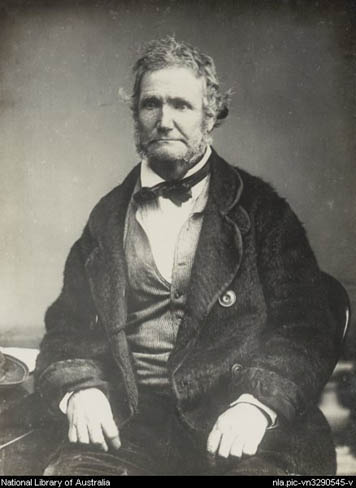
Martin Cash (1808–1877) was a notorious convict bushranger best known for escaping twice from Port Arthur, Van Diemen’s Land.
His 1870 autobiography The Adventures of Martin Cash, ghostwritten by the former convict James Lester Burke, became a best seller in Australia. Born in Enniscorthy, County Wexford, Ireland, Cash was brought up in a wealthy family and was literate.
When eighteen years of age he became acquainted with a young woman of Enniscorthy, who earned a living by making straw hats and bonnets.
She and her family borrowed money from him until his mother, alarmed at the effect of her son’s reckless spending on her remaining wealth, put a stop to it. Subsequently he became involved in an event which changed the whole course of his life.
His memoirs describe that, in a jealous rage, he shot and wounded a man named Jessop for making advances to his sweetheart. Cash was sentenced to seven years penal transportation. In due course, he and 170 other convicts left Cook Harbour on the Marquis of Huntley, arriving in Sydney Town in February 1828.
Cash was “assigned” to Mr G. Bowman of Richmond, working for him as a stockman for nine years.
John Boodle, who had a station on Liverpool Plains, asked Cash to assist him and his brother to brand some cattle which, unknown to Cash, had been stolen. While the branding was in progress two strangers came along, remained a few minutes, and departed. Upon Boodle informing him that the strangers knew the cattle were stolen, and that transportation to Norfolk Island was the penalty for this crime, Cash decided to leave for Van Diemen’s Land. He sailed in the barque Francis Freeling for Hobart Town, and arrived in February 1837.[1]
In Van Diemen’s Land, Cash soon got into trouble again, and eventually came before John Price, a magistrate in Hobart Town who sentenced him to two years in addition to his original seven years’ sentence, and to four years’ imprisonment with hard labour at Port Arthur; the so called escape proof prison.
He escaped before beginning his sentence but was immediately recaptured. Eighteen months was added to his time. Again he escaped, and almost made it to Bass Strait with his partner Bessie, but was caught and now faced 10 years at Port Arthur.
His first attempt at escape from Port Arthur failed; however he managed to swim across the purportedly shark infested Eaglehawk Bay, near Eaglehawk Neck, the first person to do so. This experience would later prove useful as it earned him much respect from other prisoners.
On Boxing Day 1842 Martin Cash, George Jones and Lawrence Kavenagh absconded from a work party. Hiding in dense scrub and with little food they made their way ten miles (fifteen kilometres) to the neck. Swimming across the bay with their clothes tied in bundles above their heads, they made the other side, all three of them having lost their bundles. Now naked, the trio robbed a road gang’s hut for clothing, and began a twenty month spree of bushranging – robbing mail coaches, homesteads and inns.
The three became known as Cash and Co and their reputation grew; however in August 1843 Cash discovered his partner Bessie was with another man in Hobart. Enraged, Cash swore to kill them both and he made his way to Hobart. On 29 August 1843 he was spotted in Brisbane St. Hobart, near the old Commodore Inn and a gunfight ensued. Constable Peter Winstanley was shot by Cash and died two days later. Cash was tried for murder in September 1843.[2]
Cash was found guilty and sentenced to death by hanging, but a last minute reprieve saw him sentenced to transportation for life at Norfolk Island. There he eventually became a trustee, and later a constable.
His marriage in 1854 produced a daughter named Monique. Cash was granted his ticket of leave the same year. Between 1854 and 1856 he was an overseer in the Royal Hobart Botanical Gardens.[3] and then in 1860 he travelled to Christchurch, New Zealand, where he kept several brothels. Cash became a free man in 1863.
Cash died in his bed in Glenorchy, Tasmania, in 1877. He is one of the few bushrangers to die of old age. During the late 1860s he had dictated his autobiography to an amanuensis, James Lester Burke. This account, although often embellished, provides an insight into convict life. Buck Thor and Joan Dehle Emberg later transcribed this account from the original manuscript and released it as The Uncensored Story of Martin Cash.
References
- ^ “THE LATE MARTIN CASH.”. Launceston Examiner (Tas. : 1842 – 1899) (Tas.: National Library of Australia). 1 September 1877. p. 5. Retrieved 16 April 2012.
- ^ “Centenary Of A Tasmanian Bushranger’s Exploits.”. The Mercury (Hobart, Tas. : 1860 – 1954) (Hobart, Tas.: National Library of Australia). 19 October 1943. p. 7. Retrieved 16 April 2012.
- ^ “Hobart – Places”. Sydney Morning Herald. Retrieved 2011-02-22.
Bibliography
- “Trial of Martin Cash”. Retrieved 9 January 2006.
- “Martin Cash – Tasmanian Bushranger”. Archived from the original on 2 September 2005. Retrieved 9 January 2006.
- “Bushranger Profiles: Martin Cash”. Retrieved 9 January 2006.
- “Dictionary of New Zealand Biography: Martin Cash”. Retrieved 9 January 2006.
- Serle, Percival (1949). “Cash, Martin”. Dictionary of Australian Biography. Sydney: Angus and Robertson.
